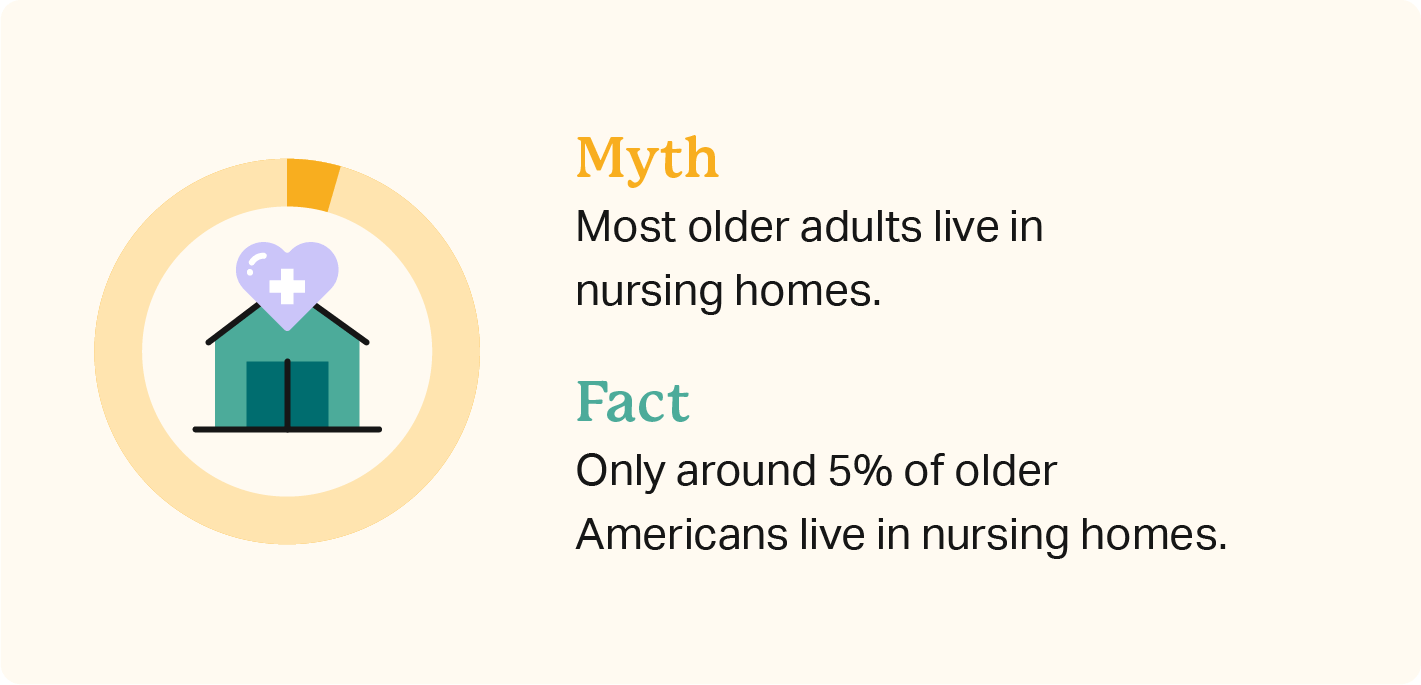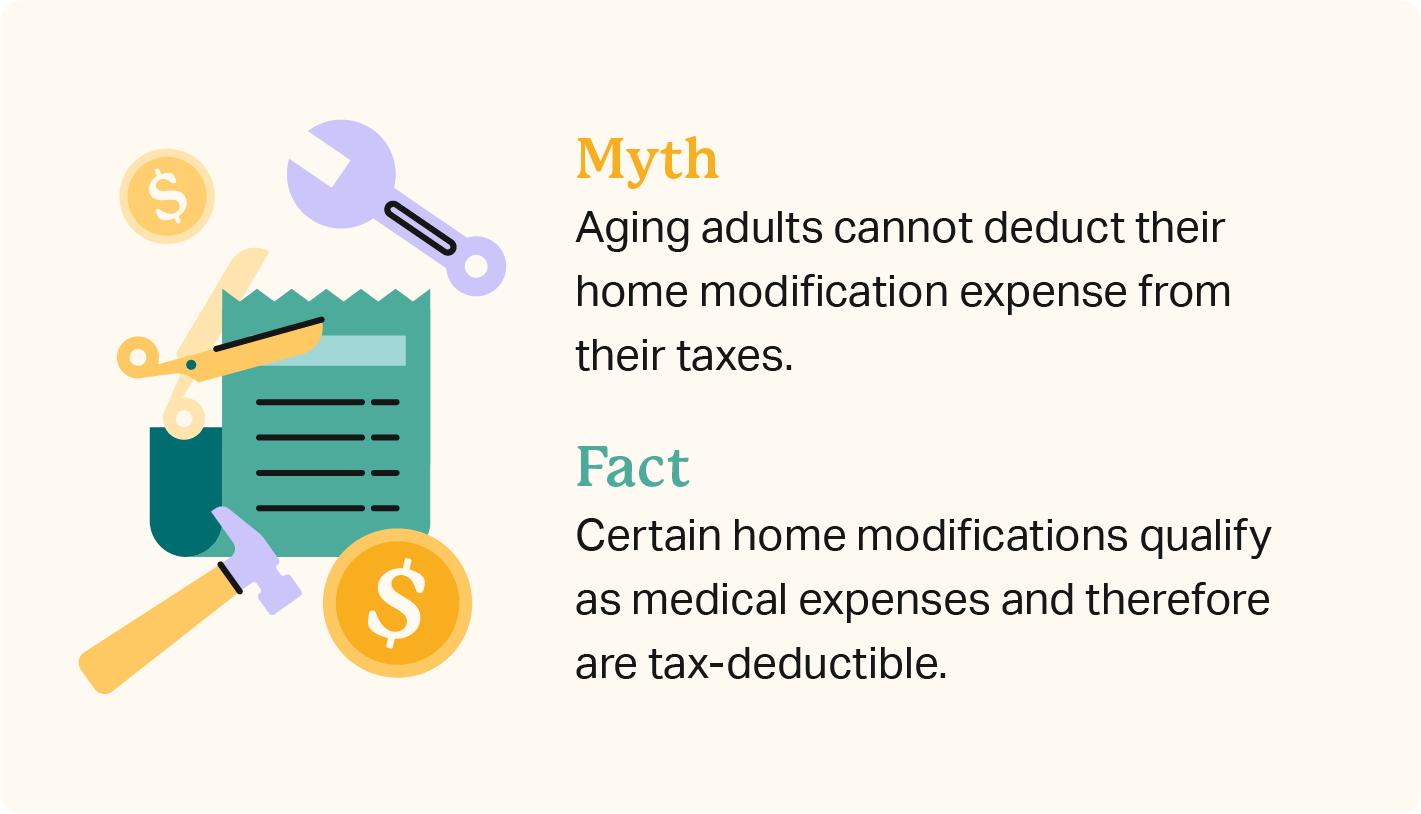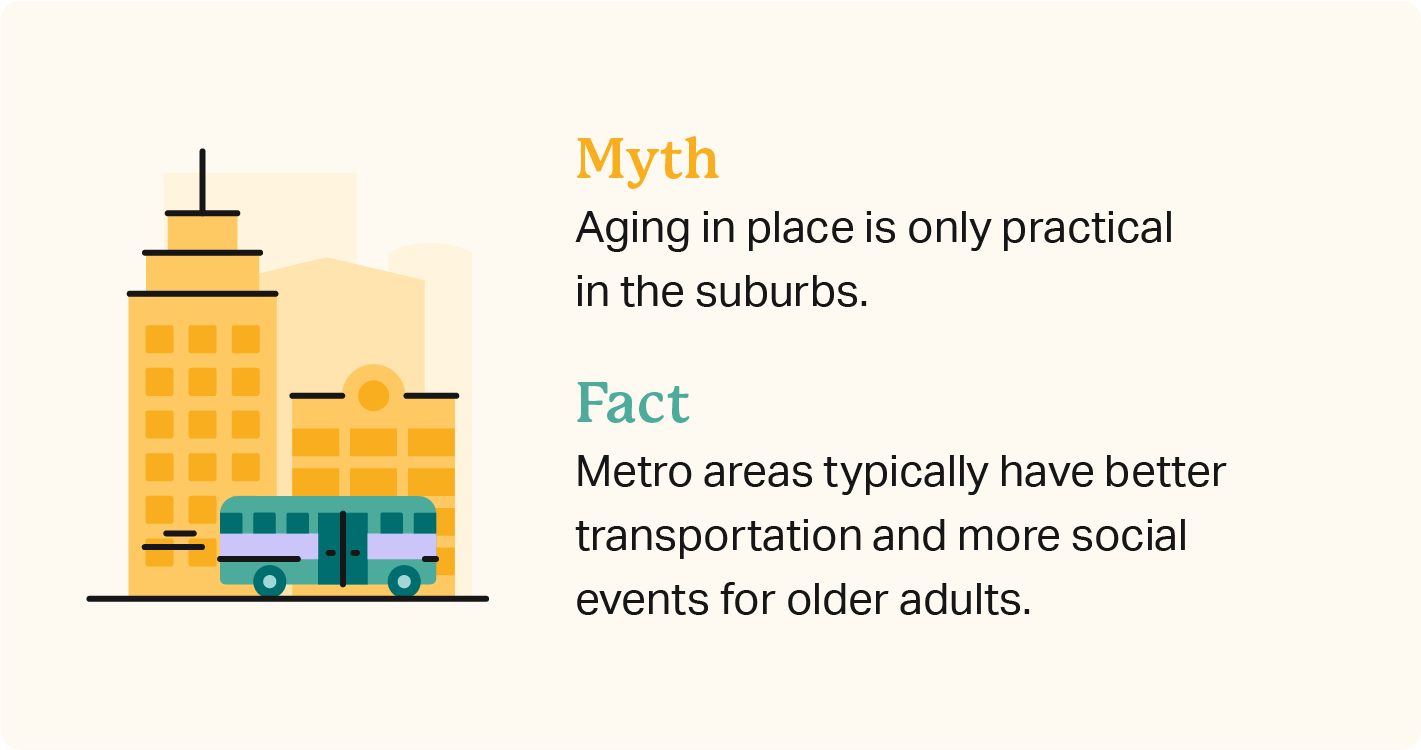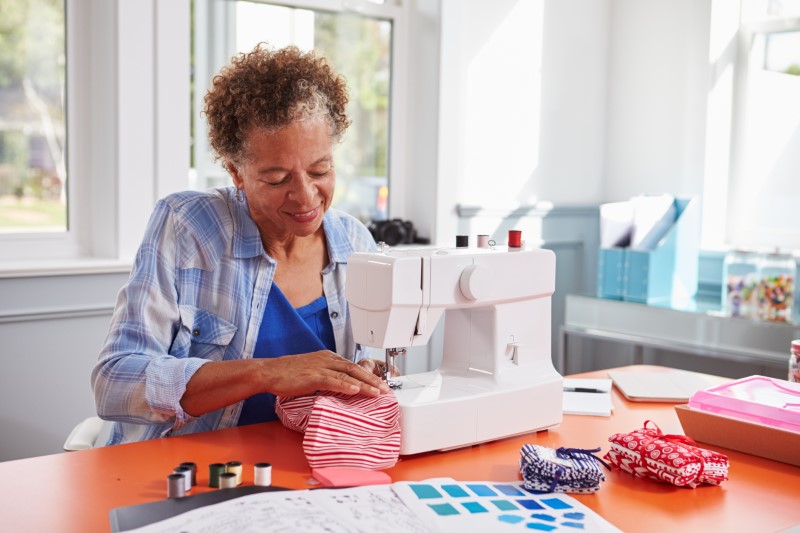Aging In Place Statistics At A Glance
Most older Americans have their minds set on staying in their own homes as long as possible. While COVID-19 and the rising costs of assisted living facilities play a role, seniors value their independence above all.
- 9 in 10 older adults prefer to live at home in their later years than in an assisted living facility. (Source)
- 8 in 10 older adults currently live independently in their own homes. (Source)
- The cost to live in an assisted living community is about $54,000 per year ($4,500 monthly). (Source)
- 83% of seniors say they feel safer in their homes than anywhere else. (Source)
- Over 60% of seniors say they have an emotional attachment to their home. (Source)
- 40% of seniors said “independence” is the most important benefit of staying in their home. (Source)
- Nearly three-quarters (72%) of low- to moderate-income seniors report having a chronic illness. (Source)
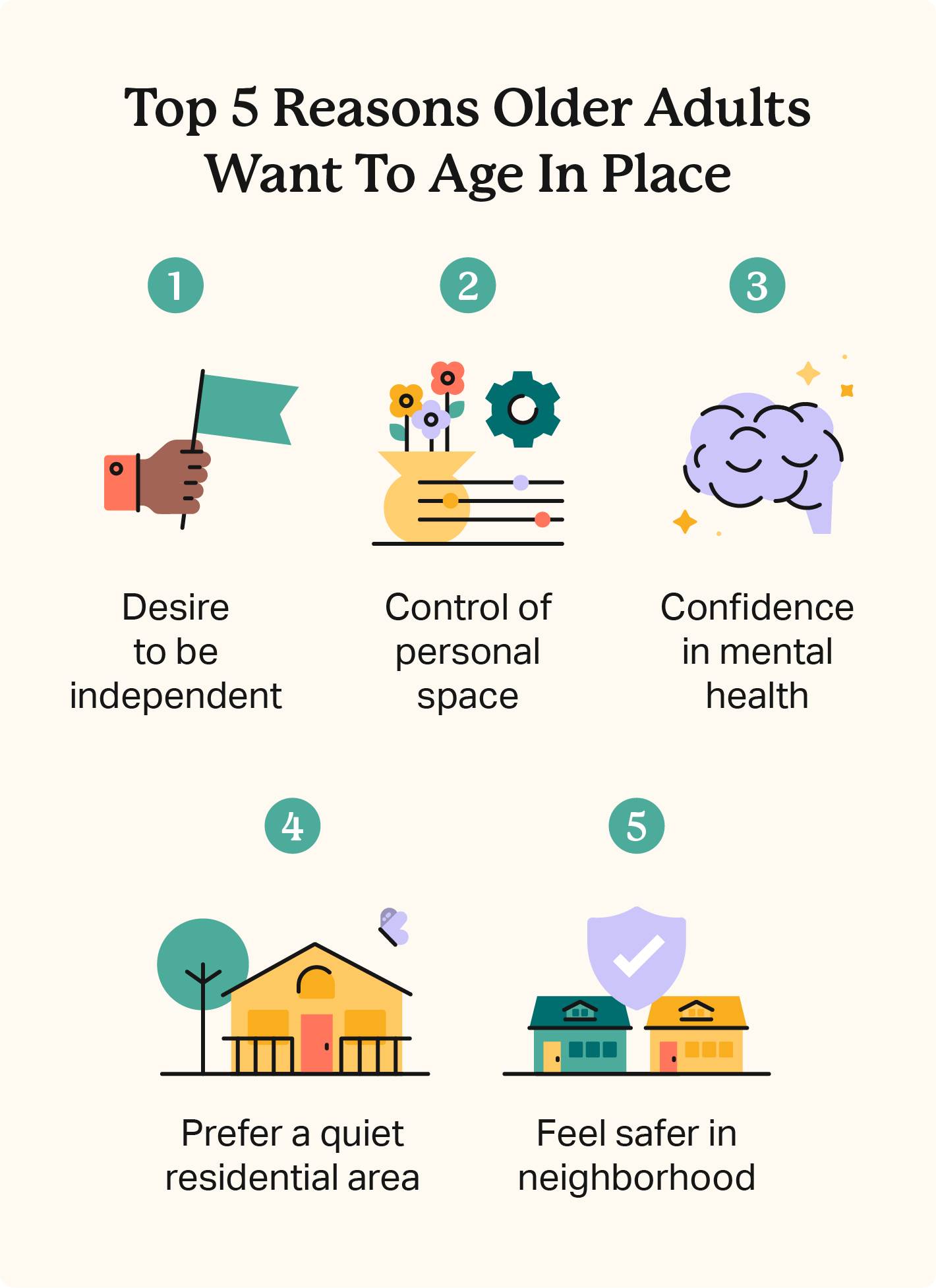
COVID-19 influence
- 7 in 10 older adults preferred staying in their community than moving during the COVID-19 pandemic (Source)
- In response to public health orders to stay home, more older adults began using technology for social connection. (Source)
- More than three-quarters (76%) of adults ages 50 and over saw the importance of high-speed internet. (Source)
- 19% of U.S. adults aged 65+ reported either using up most or all of their savings or losing their source of income as a result of the coronavirus pandemic. (Source)
- 19% of aged 65+ older adults in the U.S. reported financial hardship during COVID-19, compared to just 10% in the U.K. (Source)
- Half of older adults said the pandemic made them more willing to live at home for the rest of their lives. (Source)
Caregiver support and impact
- 20% of Americans are family caregivers. (Source)
- Caregivers living with their recipient spend over 37 hours per week on caregiving duties. (Source)
- Caregivers provide an estimated $470 billion of free labor per year. (Source)
- 2 in 10 Americans ages 70 and up say they can’t or find it difficult to live independently without help from caregivers. (Source)
- Services of a visiting caregiver cost as much as $4,000 per month. (Source)
Common Misconceptions Of Aging In Place
Growing older can be a taboo topic of discussion, with many assumptions and misunderstandings about senior living. Below, we clarify a few common myths associated with aging and reasons to have a positive outlook.
1. It’s a common myth that most seniors live in nursing homes, but only about 5% of older Americans live in nursing homes. (Source)
2. Getting involved in community activities will keep you socially active.
Reality: Up to 24% of community-dwelling older adults still experience social isolation. (Source)
3. While not all home modifications are not tax-deductible, some upgrades that accommodate disabled and medical conditions qualify as medical expenses to the IRS. This makes them tax-deductible. (Source)
4. Aging citizens feel lonely when living alone.
Reality: 77% of older adults maintain contact or social interactions at least once a week with their family, friends, and neighbors. (Source)
5. Aging in place is about aging.
Reality: The term is actually about livability, where the focus is also on comfort, not just accommodating physical limitations. (Source)
6. Choosing to stay home as you age is ideal for metro areas rather than the suburbs. Big cities tend to have better public transportation and more social opportunities. (Source)
Benefits of aging in place
It’s understandable why senior citizens feel most comfortable staying in their own homes. Here are a few more reasons to support aging in place:
Health and Safety: As more nursing homes experience overcrowding, there is also more exposure to sickness and, therefore, a higher risk of infection.
Independence: Older adults will still have some control over their daily routines and activities, creating more freedom and a sense of dignity. This is less likely in senior living communities, where residents depend on staff more.
Sense of Familiarity: Remaining near one’s community provides security for many aging adults, where leaving their environment can create an emotional toll.
Proximity to Loved Ones: It’s much easier to maintain a connection with family and friends in one’s home compared to the visitation restrictions of an assisted living facility.
Affordability: Even with home modifications and hired aid, the overall costs of nursing homes and assisted living facilities are still more expensive.
Aging In Place Remodeling
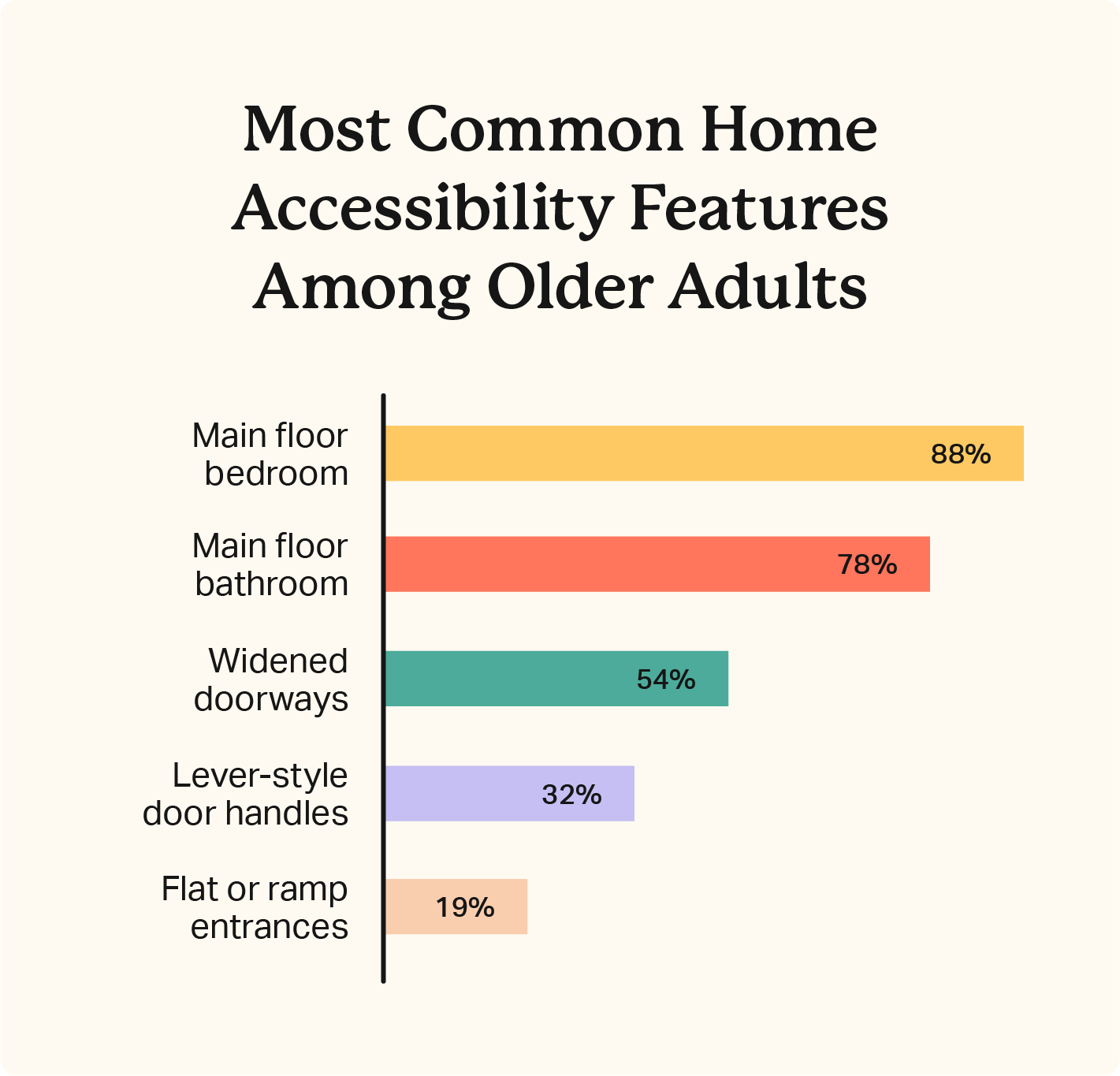
Remodeling a home can be costly but is likely necessary for seniors to safely and comfortably age in place. Below are stats on popular modifications among older adults and those costs compared to assisted living facilities.
Trends
- Home modifications for accessibility can cost $10,000-$100,000. (Source)
- Assisted living costs $45,000 per year, which after a few short years will far exceed the expenses of home remodeling. (Source)
- Over half (52%) of older adults who moved in the past five years chose a home that was easier to get around. (Source)
- The top two accessibility features among older adults are main floor bathrooms (88%) and main floor bedrooms (78%) (Source)
- Other common features include wider doorways (54%), lever-style door handles (32%), and entrances with ramps or no stairs (19%). (Source)
- Nearly half (49%) of older adults said they own at least one smart home device. (Source)
- The most popular smart technologies older adults use include voice-controlled assistive devices (18%), smart thermostats (18%), and doorbell cameras (16%). (Source)
Preparedness
- 9 in 10 U.S. homes are not ready to accommodate aging adults. (Source)
- 85% of seniors planning to stay in their current homes don’t believe they’ll need significant home modifications. (Source)
- About 1 in 5 (21%) older adults haven’t thought about modifications they’d need at home. (Source)
- Over three quarters of seniors already have someone who can assist them with groceries, household chores, and managing finances. (Source)
- Nearly 80% of older adults said they’d need bathroom modifications such as grab bars and walk-in showers. (Source)
- Roughly one-fifth of seniors (21%) over age 65 have completely paid off their mortgages. (Source)
How To Age In Place Comfortably
There’s no one-size-fits-all method to aging in place. You can still maintain your independence and receive help along the way. Identify the best care for your specific situation. Here are a few ways and resources you can use to be prepared and enjoy your golden years.
1. Invest in home modifications for safety
Perform a home safety check to analyze what modifications will be necessary to help prevent falls and accidents as you age. This may include adding handrails to stairs, shower seats and bathroom grab bars, and nonslip flooring throughout the house. Medical alert systems may also be a good investment in case of emergencies.
2. Make a care plan
Think about who will be available to help with tasks such as housekeeping, shopping, meal prep, and personal care. If you’re caring for an elderly parent, consider the costs of hired assistance. Even part-time assistance to relieve duties can help prevent caregiver burnout.
3. Manage your physical health
It’s important to prioritize your health as you age, such as incorporating a balanced diet and regular exercise into your regimen. There are also plenty of safe activities for seniors to promote social and physical activity.
4. Look into additional insurance
Even with a healthy diet and exercise, older adults are likely to have reduced flexibility and less physical strength as they age. Medicare doesn’t cover long-term care or assisted living services. For this reason, it’s ideal to look into additional insurance options that offer medical coverage in case of accidents or progressing chronic conditions.
5. Utilize community resources
Get more familiarized with using technology such as laptops and smartphones. These devices not only help you stay connected with loved ones but also let you take advantage of online shopping and delivery services.
6. Have a financial plan
Last but not least, it’s important to know what you can afford and should budget for the future, especially if you’re on a fixed income during retirement. In these cases, it may be helpful to speak with financial and estate planning experts for insight on trusts and wills, as well as how to handle any debts after your departure.
Plan Ahead With Final Expense Insurance
It’s never too early to plan. Aging in place isn’t just about preserving your quality of life but also making the necessary changes and financial arrangements to cover unexpected needs and costs in the future.
Check out the final expense life insurance guide to learn more about coverage and the best policy options for your needs.
Choice Mutual often cites third-party websites to provide context and verification for specific claims made in our work. We only link to authoritative websites that provide accurate information. You can learn more about our editorial standards, which guide our mission of delivering factual and impartial content.
- Source. https://www.aag.com/home-survey/
- Source. https://www.ncbi.nlm.nih.gov/pmc/articles/PMC3209521/#R10
- Source. https://www.ahcancal.org/Assisted-Living/Facts-and-Figures/Pages/default.aspx
- Source. https://www.aag.com/home-survey/
- Source. https://www.aag.com/home-survey/
- Source. https://www.aag.com/home-survey/
- Source. https://aginginplace.org/aging-in-place-vs-assisted-living/
- Source. https://journals.sagepub.com/doi/10.1177/0733464817748779
- Source. https://www.ncbi.nlm.nih.gov/pmc/articles/PMC9982397/
- Source. https://milkeninstitute.org/article/pandemic-stress-testing-aging-place
- Source. https://www.aarp.org/home-family/your-home/info-2021/home-and-community-preferences-survey.html
- Source. https://www.commonwealthfund.org/publications/surveys/2021/sep/impact-covid-19-older-adults
- Source. https://www.commonwealthfund.org/publications/surveys/2021/sep/impact-covid-19-older-adults
- Source. https://www.aag.com/home-survey/
- Source. https://www.aarp.org/home-family/your-home/info-2021/home-and-community-preferences-survey.html
- Source. https://www.aplaceformom.com/caregiver-resources/articles/caregiver-statistics
- Source. https://www.aplaceformom.com/caregiver-resources/articles/caregiver-statistics
- Source. https://aginginplace.org/aging-in-place-vs-assisted-living/
- Source. https://aginginplace.org/aging-in-place-vs-assisted-living/
- Source. https://www.apa.org/pi/aging/resources/guides/older
- Source. https://www.healthaffairs.org/doi/10.1377/hlthaff.2020.01470
- Source. https://www.irs.gov/publications/p502#en_US_2022_publink1000178902
- Source. https://www.healthyagingpoll.org/reports-more/report/older-adults-preparedness-age-place
- Source. https://homehealthcarenews.com/2016/10/3-myths-holding-back-aging-in-place/
- Source. https://homehealthcarenews.com/2016/10/3-myths-holding-back-aging-in-place/
- Source. https://www.healthyagingpoll.org/reports-more/report/older-adults-preparedness-age-place
- Source. https://aginginplace.org/aging-in-place-vs-assisted-living/
- Source. https://aginginplace.org/aging-in-place-vs-assisted-living/
- Source. https://www.healthyagingpoll.org/reports-more/report/older-adults-preparedness-age-place
- Source. https://www.healthyagingpoll.org/reports-more/report/older-adults-preparedness-age-place
- Source. https://www.healthyagingpoll.org/reports-more/report/older-adults-preparedness-age-place
- Source. https://www.healthyagingpoll.org/reports-more/report/older-adults-preparedness-age-place
- Source. https://www.healthyagingpoll.org/reports-more/report/older-adults-preparedness-age-place
- Source. https://www.census.gov/library/stories/2020/06/old-housing-new-needs.html#:~:text=Only%201%20in%2010%20U.S.,ready%20to%20accommodate%20older%20populations.
- Source. https://aginginplace.org/aging-in-place-vs-assisted-living/
- Source. https://www.healthyagingpoll.org/reports-more/report/older-adults-preparedness-age-place
- Source. https://www.healthyagingpoll.org/reports-more/report/older-adults-preparedness-age-place
- Source. https://www.aarp.org/home-family/your-home/info-2021/home-and-community-preferences-survey.html
- Source. https://aginginplace.org/aging-in-place-vs-assisted-living/
- National Institute of Health. https://www.ncbi.nlm.nih.gov/pmc/articles/PMC3209521/#R10
- American Advisors Group. https://www.aag.com/home-survey/
- The Commonwealth Fund. https://www.commonwealthfund.org/publications/surveys/2021/sep/impact-covid-19-older-adults
- AHCANCAL.org. https://www.ahcancal.org/Assisted-Living/Facts-and-Figures/Pages/default.aspx
- APA.org. https://www.apa.org/pi/aging/resources/guides/older
- HealthAffairs.org. https://www.healthaffairs.org/doi/10.1377/hlthaff.2020.01470
- Census.gov. https://www.census.gov/library/stories/2020/06/old-housing-new-needs.html#:~:text=Only%201%20in%2010%20U.S.,ready%20to%20accommodate%20older%20populations.
- Journal of Applied Gerontology. https://journals.sagepub.com/doi/10.1177/0733464817748779
- A Place for Mom. https://www.aplaceformom.com/caregiver-resources/articles/caregiver-statistics
- Home Health Care News. https://homehealthcarenews.com/2016/10/3-myths-holding-back-aging-in-place/
- AgingInPlace.org. https://aginginplace.org/aging-in-place-vs-assisted-living/
- IRS. https://www.irs.gov/publications/p502#en_US_2022_publink1000178902
- HealthyAgingPoll.org. https://www.healthyagingpoll.org/reports-more/report/older-adults-preparedness-age-place
- NIH (COVID-19). https://www.ncbi.nlm.nih.gov/pmc/articles/PMC9982397/
- Milken Institute. https://milkeninstitute.org/article/pandemic-stress-testing-aging-place



